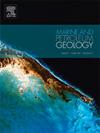甲烷水合物储层产气的水力和热控制
IF 3.7
2区 地球科学
Q1 GEOSCIENCES, MULTIDISCIPLINARY
引用次数: 0
摘要
研究了降压条件下流体流动和热输运对甲烷水合物储层产气的控制作用。研究发现,含水沉积层的有效渗透率是决定储层响应和产气量的主要因素。有效渗透率决定了水流速度和压力传播速度。这些传播速度产生了两种不同的水合物解离行为,这反过来又导致了两种不同的产气机制。在有效渗透率较高的储层中(>;10−16 m2或>;10−1 mD),低压波传播迅速,形成一个宽的,横向膨胀的水合物解离区。这个大的分离区导致释放游离甲烷气体的广阔区域,支持井筒的高速产气。随着时间的推移,水合物解离带不断扩大,直至到达储层侧缘,提高了产气量和累积气水比。热传导的增加进一步加快了产气速度。相反,在有效渗透率(<;10−18 m2或<;10−3 mD),压力传播更受限制,这将水合物解离的程度限制在一个狭窄的界面上。这种受限的解离区导致产气量显著降低,随着时间的推移,产气量的增加微乎其微,气水产量比也在下降。这些结论是基于一个多相流、多组分反应输运数值模型得出的,该模型应用于初始有效渗透率跨越5个数量级的水合物储层。我们的研究结果强调了准确表征含水合物沉积物的有效渗透率的重要性,特别是在甲烷水合物存在和沉积物压实的背景下,以评估天然气水合物作为能源的可行性。本文章由计算机程序翻译,如有差异,请以英文原文为准。
Hydraulic and thermal controls on gas production from methane hydrate reservoirs
This study explores the controls of fluid flow and heat transport on gas production from methane hydrate reservoirs under depressurization. We find that effective water permeability of hydrate-bearing sediments plays a primary role in determining the reservoir response and gas production. Effective water permeability determines the velocity of water flow and the speed of pressure propagation. These propagation speeds give rise to two distinct behaviors of hydrate dissociation, which in turn lead to two distinct regimes of gas production. In reservoirs with high effective water permeability (> m2 or >10−1 mD), the low-pressure wave propagates rapidly, creating a wide, laterally expansive zone of hydrate dissociation. This large dissociation zone leads to a broad region where free methane gas is released, supporting a high-rate gas production at the wellbore. The hydrate-dissociation zone continuously expands with time until it reaches the lateral edge of the reservoir, enhancing both the gas production rate and the cumulative gas-to-water production ratio. Increased heat conduction further accelerates the gas production rate. Conversely, in reservoirs with low effective water permeability (< m2 or <10−3 mD), pressure propagation is more restricted, which limits the extent of hydrate dissociation to a narrow interface. This confined dissociation zone results in a significantly lower gas production rate, with minimal increase over time and a declining gas-to-water production ratio. These conclusions are based on a multiphase flow, multicomponent reactive transport numerical model applied to hydrate reservoirs with initial effective permeabilities spanning five orders of magnitude. Our findings highlight the importance of accurately characterizing the effective permeability of hydrate-bearing sediments, particularly in the context of methane hydrate presence and sediment compaction, to assess the viability of gas hydrates as an energy resource.
求助全文
通过发布文献求助,成功后即可免费获取论文全文。
去求助
来源期刊

Marine and Petroleum Geology
地学-地球科学综合
CiteScore
8.80
自引率
14.30%
发文量
475
审稿时长
63 days
期刊介绍:
Marine and Petroleum Geology is the pre-eminent international forum for the exchange of multidisciplinary concepts, interpretations and techniques for all concerned with marine and petroleum geology in industry, government and academia. Rapid bimonthly publication allows early communications of papers or short communications to the geoscience community.
Marine and Petroleum Geology is essential reading for geologists, geophysicists and explorationists in industry, government and academia working in the following areas: marine geology; basin analysis and evaluation; organic geochemistry; reserve/resource estimation; seismic stratigraphy; thermal models of basic evolution; sedimentary geology; continental margins; geophysical interpretation; structural geology/tectonics; formation evaluation techniques; well logging.
 求助内容:
求助内容: 应助结果提醒方式:
应助结果提醒方式:


